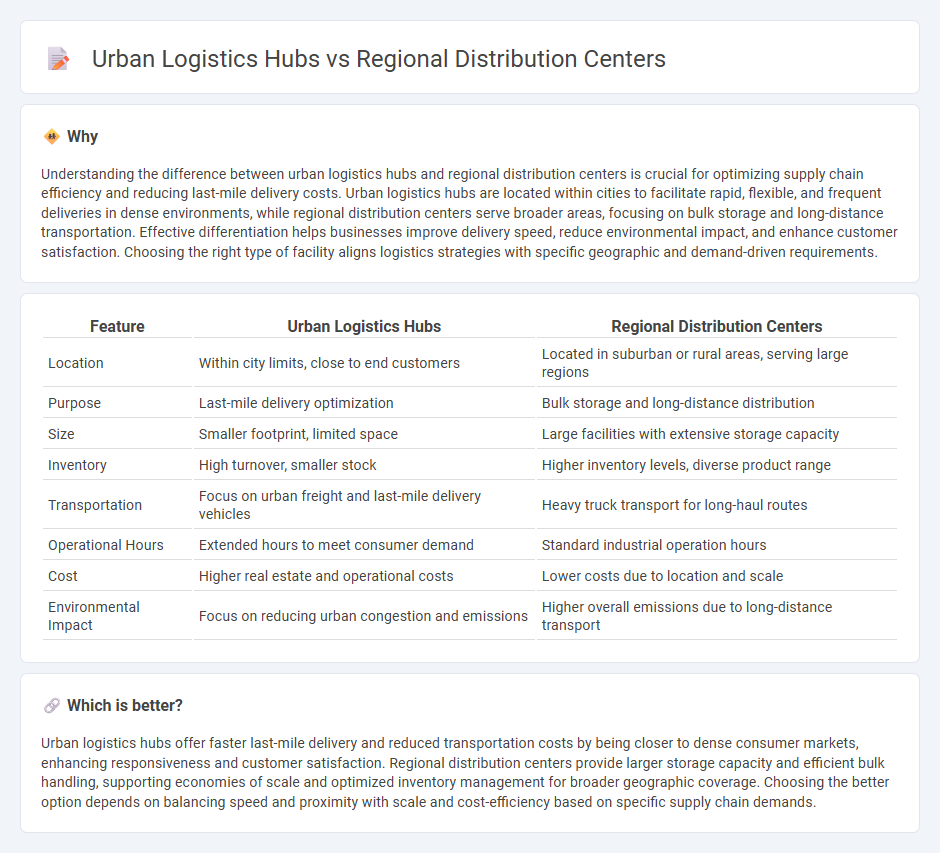
Urban logistics hubs focus on efficient last-mile delivery within densely populated cities, optimizing rapid parcel sorting and minimizing transportation times to consumers. Regional distribution centers serve broader geographic areas, consolidating inventory and enabling bulk shipments to urban hubs or direct retail outlets. Explore how these two facility types enhance supply chain efficiency in distinct ways.
Why it is important
Understanding the difference between urban logistics hubs and regional distribution centers is crucial for optimizing supply chain efficiency and reducing last-mile delivery costs. Urban logistics hubs are located within cities to facilitate rapid, flexible, and frequent deliveries in dense environments, while regional distribution centers serve broader areas, focusing on bulk storage and long-distance transportation. Effective differentiation helps businesses improve delivery speed, reduce environmental impact, and enhance customer satisfaction. Choosing the right type of facility aligns logistics strategies with specific geographic and demand-driven requirements.
Comparison Table
| Feature | Urban Logistics Hubs | Regional Distribution Centers |
|---|---|---|
| Location | Within city limits, close to end customers | Located in suburban or rural areas, serving large regions |
| Purpose | Last-mile delivery optimization | Bulk storage and long-distance distribution |
| Size | Smaller footprint, limited space | Large facilities with extensive storage capacity |
| Inventory | High turnover, smaller stock | Higher inventory levels, diverse product range |
| Transportation | Focus on urban freight and last-mile delivery vehicles | Heavy truck transport for long-haul routes |
| Operational Hours | Extended hours to meet consumer demand | Standard industrial operation hours |
| Cost | Higher real estate and operational costs | Lower costs due to location and scale |
| Environmental Impact | Focus on reducing urban congestion and emissions | Higher overall emissions due to long-distance transport |
Which is better?
Urban logistics hubs offer faster last-mile delivery and reduced transportation costs by being closer to dense consumer markets, enhancing responsiveness and customer satisfaction. Regional distribution centers provide larger storage capacity and efficient bulk handling, supporting economies of scale and optimized inventory management for broader geographic coverage. Choosing the better option depends on balancing speed and proximity with scale and cost-efficiency based on specific supply chain demands.
Connection
Urban logistics hubs serve as critical nodes managing last-mile delivery within city centers, while regional distribution centers handle bulk inventory storage and order fulfillment at a broader geographic scale. The seamless flow of goods between these facilities is enabled by integrated transportation networks, advanced supply chain management systems, and real-time data analytics. Efficient coordination reduces delivery times, optimizes inventory levels, and supports sustainable urban mobility initiatives.
Key Terms
Inventory Management
Regional distribution centers optimize inventory management by holding large stock volumes to serve extensive geographic areas efficiently, reducing shipment frequency and transportation costs. Urban logistics hubs focus on last-mile delivery, maintaining smaller, fast-moving inventory closer to high-demand urban customers to ensure quicker response times. Explore the strategic differences to enhance your supply chain efficiency and meet customer expectations effectively.
Last-Mile Delivery
Regional distribution centers serve as large-scale inventory storage facilities located on city outskirts, optimizing bulk shipments and reducing transportation costs over long distances. Urban logistics hubs operate within city centers, enabling faster, flexible last-mile delivery by strategically positioning goods closer to end consumers. Explore the comparative efficiency and impact of these facilities on modern last-mile delivery strategies.
Transportation Network
Regional distribution centers optimize supply chain efficiency by serving broad geographic areas with high-capacity storage and facilitating bulk transportation via highways and rail networks. Urban logistics hubs prioritize last-mile delivery within densely populated areas, leveraging proximity to consumers and multimodal transport options such as bike couriers, electric vans, and micro-fulfillment centers. Explore the strategic differences and operational impacts of these transportation networks to enhance your logistics planning.
Source and External Links
Regional vs. Centralized Distribution: Evaluating Approaches for ... - This article compares regional distribution, which involves multiple strategic locations for faster delivery, with centralized distribution, focusing on delivery speed and inventory management.
What is RDC Delivery? Regional Distribution Centres - This page explains how regional distribution centers (RDCs) can enhance product availability and delivery times by providing dedicated storage and distribution facilities.
Regional Distribution - This resource highlights the Texas Innovation Corridor as a prime location for regional distribution centers due to its cost-competitive sites and infrastructure support.
 dowidth.com
dowidth.com